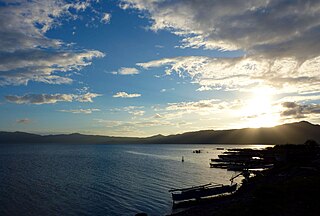
Mainit, officially the Municipality of Mainit, is a 4th class municipality in the province of Surigao del Norte, Philippines. According to the 2020 census, it has a population of 28,019 people.

Burgos, officially the Municipality of Burgos, is a 6th class municipality in the province of Surigao del Norte, Philippines. According to the 2020 census, it has a population of 4,185 people.

Del Carmen, officially the Municipality of Del Carmen, is a 5th class municipality in the province of Surigao del Norte, Philippines. According to the 2015 census, it has a population of 18,392 people. The municipality was formerly called Numancia until 1966 when it was changed to its present name. It is located on Siargao Island and home to Sayak Airport, the island's main airport.

Gigaquit, officially the Municipality of Gigaquit, is a 4th class municipality in the province of Surigao del Norte, Philippines. According to the 2020 census, it has a population of 21,849 people.

Malimono, officially the Municipality of Malimono, is a 5th class municipality in the province of Surigao del Norte, Philippines. According to the 2020 census, it has a population of 18,852 people.

Pilar, officially the Municipality of Pilar, is a 5th class municipality in the province of Surigao del Norte, Philippines. According to the 2020 census, it has a population of 10,374 people.

San Benito, officially the Municipality of San Benito, is a 6th class municipality in the province of Surigao del Norte, Philippines. According to the 2020 census, it has a population of 5,663 people.

San Isidro, officially the Municipality of San Isidro, is a 5th class municipality in the province of Surigao del Norte, Philippines. According to the 2020 census, it has a population of 8,519 people.

Sison, officially the Municipality of Sison, is a 5th class municipality in the province of Surigao del Norte, Philippines. According to the 2020 census, it has a population of 14,290 people.

Socorro, officially the Municipality of Socorro, is a 4th class municipality in the province of Surigao del Norte, Philippines. According to the 2020 census, it has a population of 25,942 people.
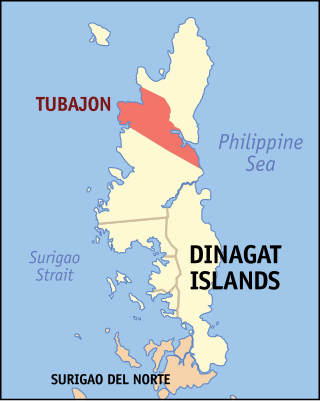
Tubajon, officially the Municipality of Tubajon, is a 5th class municipality in the province of Dinagat Islands, Philippines. According to the 2020 census, it has a population of 8,119 people.
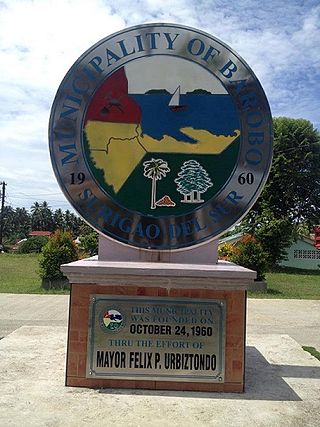
Barobo, officially the Municipality of Barobo, is a 3rd class municipality in the province of Surigao del Sur, Philippines. According to the 2020 census, it has a population of 53,146 people.

Bayabas, officially the Municipality of Bayabas, is a 5th class municipality in the province of Surigao del Sur, Philippines. According to the 2020 census, it has a population of 8,979 people.
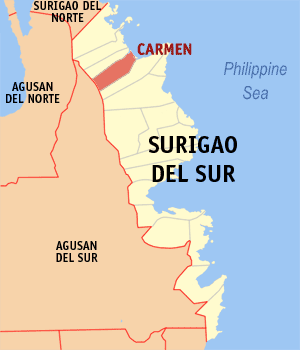
Carmen, officially the Municipality of Carmen, is a 5th class municipality in the province of Surigao del Sur, Philippines. According to the 2020 census, it has a population of 11,720 people.
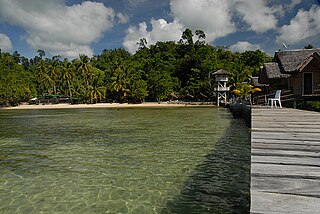
Lianga, officially the Municipality of Lianga, is a 4th class municipality in the province of Surigao del Sur, Philippines. According to the 2020 census, it has a population of 33,869 people.
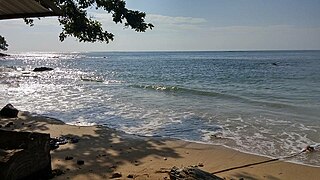
Lingig, officially the Municipality of Lingig, is a 2nd class municipality in the province of Surigao del Sur, Philippines. According to the 2020 census, it had a population of 35,142 people.

Marihatag, officially the Municipality of Marihatag ;, is a 3rd class municipality in the province of Surigao del Sur, Philippines. According to the 2020 census, it has a population of 19,441 people.

San Agustin, officially the Municipality of San Agustin, is a 4th class municipality in the province of Surigao del Sur, Philippines. According to the 2020 census, it has a population of 22,855 people.

San Miguel, officially the Municipality of San Miguel, is a 1st class municipality in the province of Surigao del Sur, Philippines. According to the 2020 census, it has a population of 41,809 people.

Tagbina, officially the Municipality of Tagbina, is a 2nd class municipality in the province of Surigao del Sur, Philippines. According to the 2020 census, it has a population of 41,051 people.






















